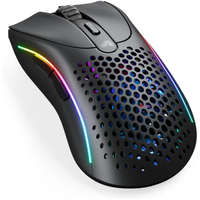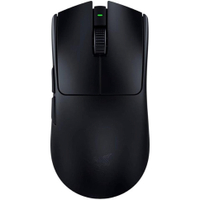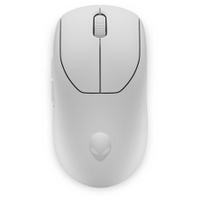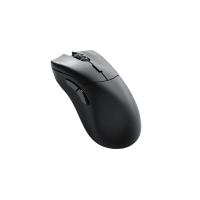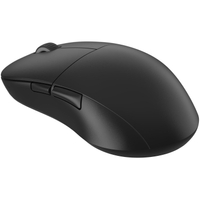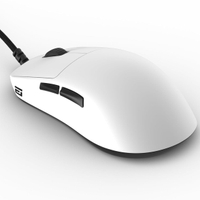Best gaming mouse in 2024: I've tested the very best mice and these are my top picks
The best gaming mouse for every game, budget, grip, and size.
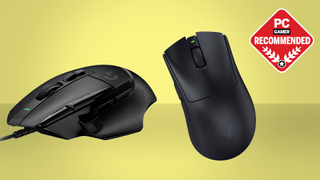
The best gaming mouse provides you with the most satisfying sweeps, clicks, and hand-feelTM possible. Whether it's lining up a perfect headshot in Counter-Strike 2 or allowing for pixel-perfect unit placement in League of Legends, the last thing you need is an unreliable rodent costing you the game. And if you're looking into a wireless gaming mouse, it should have all that and a long battery life, too.
The best wireless gaming mouse is the Razer DeathAdder V3 HyperSpeed. With its superb ergonomics, pin-sharp wireless performance and accurate sensor, it's a great pick for a wireless mouse without the drawbacks, plus it's a fair chunk cheaper than the V3 Pro. The best wired gaming mouse is the Logitech G502 X, which combines high-speed performance and stellar ergonomics into one neat and tidy wired package.
You don't need to spend a fortune to get a great gaming mouse. The best budget wireless mouse is the Logitech G305 Lightspeed, while the best wired gaming mouse is the Logitech G203 Lightsync—both have great features and performance, all while being very affordable.

Dave's been wielding mice in anger since the hoary ol' days of the Amiga 500, Deluxe Paint, and Dune 2. He even plugged one into his Commodore 64 once, but he got over that. He's had his paws on gaming mice from every big manufacturer over the past couple decades, from ultra-lights and wireless, to many-buttoned horrors made for MOBAs. So, he know a thing or two about PC rodents.
The quick list

The best overall
Tetherless and tireless, the Deathadder V3 HyperSpeed is a fantastic evolution of a beloved mouse design. With an impressive sensor and great wireless performance, there's not much to complain about. And it's a fair chunk cheaper than the V3 Pro.
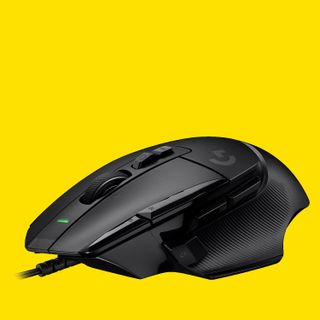
The best wired
An ergonomic and wired masterpiece, the G502 X has a good range of buttons to program—even a hot-swappable one. Pair that with a sturdy build and an infinite scroll and it's a super easy wired mouse to recommend.
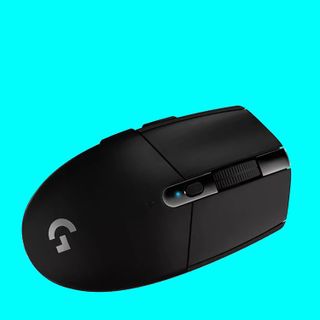
The best budget wireless
A superb back-to-basics gaming mouse, the G305 Lightspeed is a super affordable way to nab Logitech's best sensor yet. It is not a complex mouse, but it lasts ages on a single AA battery, and is light as anything.

The best budget wired
A super affordable mouse that even has RGB. The sensor's DPI may not be as granular as some out there, but it's small, uncomplex and super adorable in black or white.

The best competitive
This is one of the lightest rodents you'll find on the market today, and for something so light and well-built it doesn't cost too much, either. Throw in a great, responsive sensor and you have a cracking mouse for esports gaming.

The best MMO
Well-kitted out, the Naga Pro is a snake of many faces. Literally, you can swap out the side panel for the optimum button arrangement for assigning your quick actions, and although it's a chonker of a mouse, it's easily the most versatile.
⬇️ Click to load more of the best gaming mice⬇️
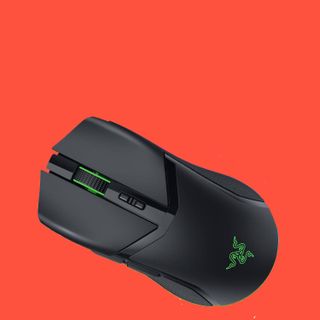
The best for small hands
The Cobra Pro is great for all you small-handers out there. This thing's a solid all-rounder just like the DeathAdder HyperSpeed, but dinky. It's great for claw- and fingertip-grippers, too.
Recent updates
Updated on September 5, 2024 to keep all our picks and information up-to-date
The best wireless gaming mouse





1. Razer DeathAdder V3 HyperSpeed
Our expert review:
Specifications
Reasons to buy
Reasons to avoid
✅ You want a great gaming mouse for a reasonable price: No unnecessary RGB, ultra-high polling rate, or ridiculously high DPI limit. It's just a stellar gaming mouse for a very good price.
❌ You want a mouse primarily for office work: This mouse has loud buttons and a clunky wheel which might annoy some when not gaming.
We've recently swapped our pick in this spot from a DeathAdder to… a DeathAdder. Yes, we reckon the best wireless gaming mouse is the Razer DeathAdder V3 HyperSpeed. It seems we just can't get enough of the viperously curvy classic, and for good reason.
Razer's DeathAdder has a long and respectable history, all the way from the original 2006 version to today. Nowadays there seem to be more than you can shake a stick at. Through all that time, it's retained the same shape, for the most part, and it's a shape that people clearly love.
We're no exception here at PC Gamer. DeathAdders are incredibly comfy to use, provided you're a righty. And this certainly hasn't changed with the DeathAdder V3 HyperSpeed. It's mighty comfortable to use, even for long gaming sessions.
But why this particular one? Well, to be blunt: value for money. While the Razer DeathAdder V3 Pro is the pinnacle of the DeathAdder series, and while we'd recommend it above the HyperSpeed if money really is no concern at all, the HyperSpeed version costs so much less and makes so few sacrifices that we'd be remiss if we didn't recommend it.
It drops max polling from 8 kHz to 1 kHz, but 8 kHz is overkill even for competitive gaming and drains the battery much quicker. Its DPI maxes out a few thousand lower than the Pro, too—but again, who really cares? 1,000 Hz polling and 26,000 DPI is more than enough for the vast majority of gamers.
Throw in the fact that it's lighter than the Pro and has 10 hours extra battery life, and it's a no-brainer, in my opinion. You're getting a high-quality hall-of-fame mouse design for a fraction of the cost of its very similar flagship sibling. For an all-round fantastic cordless mouse, the Razer DeathAdder V3 HyperSpeed is where it's at.
Read our full Razer DeathAdder V3 HyperSpeed review.
The best wired gaming mouse



Specifications
Reasons to buy
Reasons to avoid
✅ If you want exceptional ergonomic comfort: The G502 X is massively comfortable, thanks to an ergonomic shape paired with a well-placed thumb rest that keeps your hand in the optimum position.
✅ If you want great build quality, without the heaviness: A good mouse doesn't have to be heavy to feel like a substantial and well-constructed product, and the G502 proves it.
❌ You're looking for silence: The Lightforce switches may be positive and decently quick, but they make a bit of a clunk that might annoy your living companions if they're in the same room.
The Logitech G502 X is the best wired gaming mouse primarily because its beloved shape offers a gaming experience that's more than pleasant under the fingertips. Logitech's G502 shape is a classic: bold, functional, and above all, comfortable and ergonomic. Many of us at PC Gamer can attest to the sheer comfort of the G502 shape.
Not everyone wants to deal with wireless charging, and some might prefer the peace of mind a cable provides. Not to mention the price, because although prices for wireless mice are decreasing, wired mice still tend to be cheaper.
The thing is, though, most new high-end gaming mice hitting the market are wireless ones, so you usually have to look a little further back to find the best of the best in the wired market. Not so with the circa 2022 G502 X, however, because this mouse is a fantastic corded option and is pretty recent, too, meaning it has a lot of the modern additions you might hope for.
The G502 X is a little different to the original G502, primarily because it uses new opto-mechanical mouse switches and comes in a fair whack lighter than previous versions at 89 g—two very welcome changes. It still has the same Hero sensor, but this performs really well and can reach up to 25,600 DPI, so no complaints there.
Apart from these changes, though, the G502 X keeps the original G502's most beloved features, such as its toggle-able infinity scroll wheel (the wheel's now plastic, though). This can be an ergonomic life-saver when browsing or doing other scroll-intensive tasks. And its thumb rest and long side buttons still make for a super chill and ergonomically refined experience, too.
This thing is hella cheap, too, thanks to the lack of wireless capabilities, sitting well shy of $100 and much cheaper than the wireless versions. If you're in the market for a wired gaming mouse today, you can't get much better than the Logitech G502 X.
Read our full Logitech G502 X review.
The best budget wireless gaming mouse




3. Logitech G305 Lightspeed
Our expert review:
Specifications
Reasons to buy
Reasons to avoid
✅ You want a pure, unfussy gaming mouse: The G305 Lightspeed focuses on the basics, and does them well: fast performance, clicky buttons, and great accuracy.
✅ You want great battery life: While you'll need to swap out an AA battery rather than charge an internal unit, you will at least get 200 hours of usage out of each one, which is pretty good going.
❌ You want a rechargeable battery as standard: While rechargeable AA batteries are relatively cheap, it'd be nice if the G305 had an internal unit instead.
❌ You want a lot of features: The G305 Lightspeed offers everything you need, but not a huge amount extra.
With the Logitech G305 Lightspeed, Logitech has created a high-performance mouse that doesn't cost the earth, and that makes it our best budget wireless gaming mouse. Despite the low cost, there's no compromise in performance or design.
The G305 Lightspeed might not be the latest model on the market, but don't let that bother you. A good mouse is a good mouse. It's still a great value option for day-to-day use, while its light weight makes it well suited to fast-paced shooters where reaction time is paramount.
The G305 uses Logitech's Hero sensor, an iteration of the fantastic sensor Logitech's best mice, from the classic G502 down to the G Pro X Superlight. This sensor has a sensitivity range of up to 12,000 CPI (counts per inch) and can be adjusted via a button underneath the scroll wheel.
In addition to the CPI button, there are five programmable buttons. Of course, there are the left and right click buttons, which are joined by a scroll wheel and two side buttons. These are well placed for the righties out there; lefties are out of luck, though.
The left- and right-click buttons are separate pieces from the removable palm rest, ensuring a reliable and satisfying click. They're rated for 10 million clicks too, so if you're playing games that require button mashing, the G305 will serve you well. Not bad for a budget option, and something that'll likely last you for many years of heavy clicking.
Logitech has won praise for its 2.4 GHz wireless technology and cross-device compatibility. Even though lag shouldn't be an issue, the G305 comes with a USB extension cable, allowing you to place the receiver close to the mouse. The small wireless dongle can be stored inside the body of the mouse, where the single AA battery resides (which is good for a claimed 200 hours).
The shape of the G305 is based on a small, symmetrical design Logitech has been using for years. While components like the scroll wheel and buttons don't feel as premium as those in the G502, they're still far better than anything you'll find in a cheap gaming mouse. The quality and performance of the G305 are killer features for its price.
The best budget wired gaming mouse




Specifications
Reasons to buy
Reasons to avoid
✅ If you don't want to spend a lot on the basics: Sounds obvious, but the little Logitech is cheap, without feeling like it's lacking in quality.
✅ If you'd like some RGB lighting: Three zone lighting is a nice bonus for such an affordable mouse.
❌ If you want a ton of features: It's basic, and that's actually its biggest strength. If you're looking for a lot of extra buttons and do-hickeys though, it'd be worth spending up a bit.
Sometimes you just want something cheap and cheerful, and if that's what you're after, the Logitech G203 Lightsync won't disappoint because it's the best budget wired gaming mouse on the market right now, we reckon. It's shapely, comfy, functional, good-looking, and will cost you nary an arm nor a leg.
There's a lot to be said for a cheap gaming mouse like this one, too. Yes, a DeathAdder V3 HyperSpeed is nice and all, but what about a backup mouse? what about a mouse you can take out and about and don't mind getting scuffed up? Heck, what about saving some money and putting it towards a component like a new graphics card?
If any of those things sound reasonable to you, the G203 Lightsync is worth a look, not least because, despite being incredibly cheap, it offers all the basics you might want from a gaming mouse.
It's light and comfortable to use, which is the most important thing. But it's also got a pretty decent sensor and reaches up to 8,000 DPI. Sure, that's nothing like the 26k+ monsters you get at the high-end, but it's more than enough for competitive gaming at 1440p and casual gaming at 4K.
The cream on top is really the RGB lighting, though, since it's rare to get nice lighting on a solid budget gaming mouse. The G203 Lightsync, however, has three-zone RGB, and looks pretty dashing all things considered. Its gray scroll wheel looks rather nice, too.
There's not much else to this thing, it's just a solid all-round gaming mouse for surprisingly few pennies, and if you're on a budget it's one we'd definitely recommend you consider.
Read our full Logitech G203 Lightsync review.
The best gaming mouse for competitive gaming




5. Turtle Beach Burst II Air
Our expert review:
Specifications
Reasons to buy
Reasons to avoid
✅ You want ultra-lightweight: For competitive gaming, having a lightweight mouse is a must, and it doesn't get much ligher than this at 47 g.
❌ You want something fancy: You have to sacrifice quite a lot to get a mouse so light and responsive for competitive gaming, so don't expect any fancy features or RGB lighting with this mouse.
No, I didn't expect to see a Turtle Beach mouse on this list, either, but the Burst II Air is such a solid, lightweight mouse that we reckon it's actually the best mouse for competitive gaming on the market right now. It's certainly the best we've got our hands on.
The reason for this is simple: It's a ridiculously lightweight mouse at just 47g, and somehow manages this while remaining sturdy. For reference, staple lightweight mice such as the Logitech G Pro X Superlight 2 and Glorious Model O 2 weigh 60 g and 68 g, respectively.
Turtle Beach has really figured out its target market for this mouse. You want a light mouse if you want to do competitive gaming. And if you're into competitive gaming, you don't want a million bells, whistles, and other shiny things—you just want a mouse that's easy to use, works, and performs exceptionally well.
That's what the Burst Air II delivers. It's a no-frills mouse that glides across the mousepad effortlessly. Performance-wise, it's up there with the best of them, because we had zero issues with the Owl-Eye 26K Optical sensor, and its 26,000 DPI and 1,000 Hz polling, despite current 8 kHz trends, should be enough for competitive gaming.
The icing on the cake is that this thing is rated for a seriously fantastic 120-hour battery life. That's probably because it cuts out all the unnecessary fluff such as RGB lighting and unnecessarily high polling capabilities.
Instead, the Burst II Air sticks to pure function. This can be seen even in its software, which Kegan Mooney found to be very straightforward and easy to use when they tested it.
For competitive gaming, we reckon you can't get much better than the Burst II Air. (And, by the way, isn't it great that Logitech, Corsair, and Razer finally have some top-notch competition on this front?)
Read our full Turtle Beach Burst Air II review.
The best MMO gaming mouse





Specifications
Reasons to buy
Reasons to avoid
✅ If you're looking for ultimate button customisation: Those magnetic side panels give you so many potential options, it's mind-boggling.
✅ If you're looking for large and in charge: The Naga Pro is big, it's true, but it's also very comfortable, and suits those with larger hands.
❌ If you want something basic and affordable: It's a bit pricey, but all those extra features had to come with a cost somewhere. If you don't need the extra buttons, this might not be the mouse for you.
You can't think "MMO mouse" without thinking "Razer Naga," and we reckon the Razer Naga Pro is currently the best mouse for MMO gaming on the market. Yes, the Naga Pro V2 is out now, but the Naga Pro is much cheaper and doesn't sacrifice much. It's much the same situation as with the DeathAdder V3 HyperSpeed vs DeathAdder V3 Pro: If you want the absolute best you can go for the latest top-end version, but the cheaper version seems to be better value.
So, what is it that makes the Naga Pro so great for MMO gaming? If you're into MMOs you probably need to use a lot of hotkeys, and the Naga Pro delivers programmable buttons in spades for just this reason.
The Naga Pro is based primarily on the popular Razer Naga Trinity, which allows you to swap between side-button layouts. The original Nagas just had the one 12-button layout, but the Naga Pro now lets you swap between two-, six-, and 12-side-button layouts. So, it doesn't just have to be your MMO mouse, it can serve well as a day-to-day and non-MMO gaming mouse, too.
This is the main draw to the Naga Pro, but the rest of the mouse is stellar, too. Its Focus+ optical sensor is plenty responsive and offers up to 20,000 DPI which should be more than enough for gaming. It's unfortunately increased its weight to 117 g, but there was always going to be some sacrifice for the hot-swappable side-button tech.
For 117 g you'd also hope that battery life is decent, and thankfully Razer's delivered on this front, with the Naga Pro having up to 150 hours of battery life on a single charge. Throw all this into a premium-looking and -feeling package, and you have the Razer Naga Pro, the ideal mouse for MMO gaming.
Read our full Razer Naga Pro review.
The best gaming mouse for small hands




7. Razer Cobra Pro
Our expert review:
Specifications
Reasons to buy
Reasons to avoid
✅ You have small hands: This thing's great for you small-handers. And because it's not designed with any gamer archetype in mind, the Cobra Pro suits a range of playstyles.
✅ You hate charging wireless mice: Once the lights are off, this one goes on and on and on.
❌ You have large hands: The Cobra Pro is on the smaller side as far as Razer’s mice go.
❌ You want to enjoy the RGB lights: Well, you can buy it if that’s the case, but it won't last as long as you'd like.
Not everyone is handily endowed—a fact that the PC gaming industry sometimes seems to forget. Well, if you've got dinky digits, the Razer Cobra Pro might be the best mouse for you, because we reckon it's the best mouse for small hands.
Sure, there are plenty of small mice, but are there any good ones? A decent small gaming mouse is surprisingly hard to come by, but we think the Cobra Pro is the best of the bunch.
In fact, it's a solid all-rounder just like the Razer DeathAdder V3 HyperSpeed (or V3 Pro), but smaller. It's not quite light enough to sit in the "lightweight mouse" category, but not every mouse has to be light as a feather, you know? 77 g is comfy enough and lighter than many other staple gaming mice.
The proof is in the pudding, though, and Alex Blake found this thing to be incredibly comfortable to use when they tested it, finding it snappy, responsive, and suitably slippery on the mousemat (without detracting from precision, of course). Responsiveness is no doubt aided by its Focus Pro 30K Optical sensor, the 30K of course meaning it's capable of up to 30,000 DPI.
Its battery life is great at up to 100 hours over HyperSpeed wireless, but there's a big caveat here: In testing, this was only the case with RGB disabled. With its gorgeously subtle underside RGB enabled, it only lasted only a fraction of this. So, small-handed RGB lovers, consider yourselves warned.
If you're looking for a compact mouse, though, despite any RGB battery life concerns, this is what we'd recommend. It's comfortable to use and performs well, and is sized well for smaller hands or claw- or fingertip-grippers.
Read our full Razer Cobra Pro review.
Also tested
This mouse was previously our pick for the best wireless gaming mouse, but we reckon the HyperSpeed version is better value. Still, if you're happy spending a little more, the V3 Pro certainly won't disappoint.
PC Gamer score: 89%
Read our full Razer DeathAdder V3 Pro review.
Featuring an updated sensor, the second iteration of Glorious's Model D mouse is similarly comfy and performs well. However, it isn't the lightest and we think there are better lightweight options such as the Superlight V2.
PC Gamer score: 75%
Read our full Glorious Model D 2 review.
The Viper V3 Pro is a superb pick for esports gaming given its 54 g weight and up to 8 kHz polling. It's a bit of a fingerprint magnet, though, and it isn't as light as our pick for best competitive wireless gaming mouse.
PC Gamer score: 84%
Read our full Razer Viper V3 Pro review.
The Corsair M75 Wireless is a great mouse for lefties. It's genuinely ambidextrous because you can move its buttons from one side to the other. Apart from that, though, it's nothing to write home about.
PC Gamer score: 83%
Read our full Corsair M75 Wireless review.
This mouse is simply not worth the cost, in our eyes. It features a nice clean design and responsive sensor, but it has cheap-feeling side buttons and there are much better options for the high price tag. Not to mention, on the darker versions of the mouse the Alienware logo looks a little too much like a cheap sticker for my liking.
PC Gamer score: 73%
Read our full Alienware Pro Wireless gaming mouse review.
Almost a great gaming mouse but the wireless experience is frustrating in a way its rivals aren't. The customisation options are great, it feels comfortable in the hand, and the sensor is reliable and accurate, but it's just a little short of being the full package.
PC Gamer score: 74%
Read our full Mountain Makulu Max review.
Glorious Model D 2 Pro 4K/8KHz Edition
The mouse achieves what it sets out to do: provide competitive gamers with an absurd polling rate. Though ask yourself this, do you really need it? The answer is probably no, in which case there's the cheaper 1KHz version. Also, in our testing, we experienced some dropouts with the wireless connection.
PC Gamer score: 66%
Read our full Glorious Model D 2 Pro 4K/8KHz Edition review.
A snappy sensor and great response make this mouse a great choice for competitive gamers who are looking for a little extra aesthetically and feature-wise. Its surprisingly reasonable price tag doesn't go amiss, either. The only sore spot is a less-than-stellar battery life that requires some effort to get the most amount of game time.
PC Gamer score: 84%
Read our full Glorious Model O 2 Wireless review.
A humble, solid pointer that’s silky smooth on your mat. The XM2we is just a little expensive against the competition.
PC Gamer score: 70%
Read our full Endgame Gear XM2we review.
HyperX Pulsefire Haste 2 Wireless
HyperX brings you the performance and battery life you want in a lightweight wireless gaming mouse. The $90 price tag is also good enough to surpass some of its software woes.
PC Gamer score: 73%
Read our full HyperX Pulsefire Haste 2 Wireless review.
This is a fantastic wired mouse if we remove its high price tag from the equation: high polling, no drag, and smooth to use. It's just difficult to recommend it when there are better options for just a little more cash.
PC Gamer score: 81%
Read our full Endgame Gear OP1 8K Wired review.
This is a great choice for a cheap lightweight wired mouse, but unfortunately, it does feel cheap, too. Still, if you want function over fanciness and are considering competitive options for a mouse for competitive gaming, this is one to consider.
PC Gamer score: 80%
Read our full NZXT Lift 2 Symm review.
How to spot the best deal
Where are the best gaming mouse deals?
In the US:
- Amazon - Often some savings on PC gaming peripherals
- Walmart - Usually some good savings on mice
- Newegg - Big brand gaming mice for cheap
- Best Buy - Great place to look for a cheap gaming mouse
In the UK:
- Overclockers - Plenty of peripherals to choose from
- Scan - Lots of sales events including gaming mice
In Australia:
- Mwave - A huge range to choose from
- Computer Alliance - Mice to suit every budget
- Amazon - Keep an eye out for some steep discounts
Best gaming mouse Q&A
Why should I choose a gaming mouse over the average optical mouse?
For one thing, gaming mouse sensors are designed to be more responsive and accurate. With adjustable (or no) smoothing and acceleration, your aim will stay true. Gaming mice are more accessible because of their programmable buttons and versatility over a traditional mouse.
Is a wireless mouse good for gaming?
Historically the answer was always: no. The wireless connection, though convenient, was used to add extra latency to the connection compared with a wired cable, which meant input lag in games was 'a a thing'. For reference, that is also seen as a 'very bad thing' in competitive online games.
But modern wireless interfaces, primarily the 2.4 GHz radio connections, have zero perceptible difference in latency compared to a standard wired connection. Blind tests have been done with pro gamers using wired and wireless mice, and if the most sensitive players around can't tell the difference, we're confident you won't be able to either.
Bluetooth connections, however, can still introduce unwelcome input lag into a gaming situation, so that's best avoided. In modern wireless gaming mice, however, Bluetooth is only used as a low-power backup option.
What should I look out for in a gaming mouse?
When deciding on a mouse, your priority should be finding one that's comfortable for your hand. There are numerous sizes, shapes, and weights to consider. You might have the coolest-looking mouse with the most practical array of buttons, but if it's not comfortable for you, you won't be able to settle in with it. There are plenty of ambidextrous gaming mice and gaming mice for lefties in the list, too—if the goofy stance is more your style.
In the last few years, most gaming mice have also adopted very high DPI sensors (or more accurately, CPI), so even a budget mouse will likely perform well. Most of these sensors can handle extremely high DPI counts at up to 20,000 DPI when realistically, you'll play on a much lower sensitivity—generally under 2,000 DPI.
The consensus is not to worry about that number too much. Instead, concentrate on finding a mouse with the ideal shape and weight, and obviously, one that'll match your stylish set-up.
Pro gamers generally recommend lighter, more straightforward mice with few buttons to get in the way. Lighter mice won't fatigue your wrist and can easily glide across the mouse pad at high speeds. Anything below 100 grams is often ideal for competitive mice. But something has to be said about how powerful you feel at the helm of a nice heavy mouse.
How we test gaming mice
We've used enough gaming mice to have a good feel for build quality, button placement, and shape. Our opinions on those aspects of mouse design are naturally subjective, but they're also well-informed. The tricky part of testing gaming mice is analyzing the other part of the equation: tracking performance, jitter, angle snapping, acceleration, and perfect control speed, and determining how each of those issues affects the experience of using a mouse.
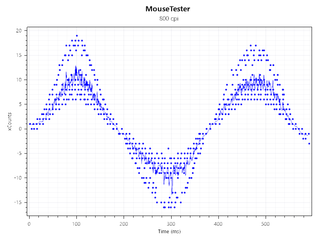
For that, applications such as Mouse Tester come in handy. We used this software to see if we could spot any glaring issues with the mice we used. In every gaming mouse we tested, though, angle snapping and acceleration were disabled in the mouse drivers by default (though a mouse can still exhibit acceleration from issues with the sensor itself) and never encountered any glaring performance issues.
For gaming, we primarily test mice with Destiny 2 and Apex Legends and twitchier shooters like Quake Champions to see how our performance stacks up against other mice. We scrutinize the cursor movement and responsiveness for lag, jitter, and other issues.
We use each mouse with its wireless receiver plugged into close by USB port, giving it the best possible wireless situation to work with. We also tested the wireless receivers plugged into our test system a few feet away with my legs in between, increasing the opportunity for lag and interference.
Jargon buster
Grip refers to how you hold the mouse. The most common grips are palm, claw, and fingertip. Here's a good example of how each grip works.
CPI stands for counts per inch, or how many times the mouse sensor will read its tracking surface, aka your mousepad, for every inch it’s moved. This is commonly referred to as DPI, but CPI is a more accurate term. The lower the CPI, the further you have to move the mouse to move the cursor on the screen.
Jitter refers to an inaccuracy in a mouse sensor reading the surface it’s tracking. Jitter often occurs at higher mouse movement speeds or higher CPIs. Jitter can make your cursor jump erratically, and even small jitter could wreck a shot in an FPS or make you misclick on a unit in an RTS.
Angle snapping, also called prediction, takes data from a mouse sensor and modifies the output to create smoother movements. For example, if you try to draw a horizontal line with your mouse, it won’t be perfect—you’ll make some subtle curves in the line, especially at higher sensitivities. Angle snapping smooths out those curves and gives you a straight line instead. This is generally bad because it means your cursor movements won’t match your hand’s movements 1:1, and angle snapping will not be useful in most games. Thankfully, almost all gaming mice have angle snapping disabled by default.
Acceleration is probably the most reviled, most scrutinized issue with gaming mouse sensors. When a mouse sensor exhibits acceleration, your cursor will move faster the faster you move the mouse. This is often considered bad because moving the mouse slowly six inches across a mousepad will move the cursor differently than moving the mouse rapidly the same distance. This introduces variability that can be hard to predict.
Perfect control speed, or malfunction rate, refers to the speed at which the mouse can be moved while still tracking accurately. Most gaming mice will track extremely accurately when moved at slow speeds, but low CPI players will often move their mice large distances across the mousepads at very high speeds. At high speeds, especially at high CPIs, not all mouse sensors can retain their tracking accuracy. The point at which the sensors stop tracking accurately will differ between CPI levels.
IPS measures inches per second and the effective maximum tracking speed of any given sensor is rated too. Not to be confused with the gaming monitor panel type by the same name, the higher the IPS of any given mouse, the better it can keep up with high-speed movement and maintain accuracy.
Lift-off distance is still a popular metric in mouse enthusiast circles, though it does not affect most gamers. LOD refers to the height a mouse has to be raised before the sensor stops tracking its surface. Some gamers prefer a mouse with a very low lift-off distance because they play at very low sensitivity and often have to lift their mouse off the pad to reset it in a position where they can continue swiping. With a low LOD, the cursor will not be moved erratically when the mouse is lifted.
The biggest gaming news, reviews and hardware deals
Keep up to date with the most important stories and the best deals, as picked by the PC Gamer team.

Dave has been gaming since the days of Zaxxon and Lady Bug on the Colecovision, and code books for the Commodore Vic 20 (Death Race 2000!). He built his first gaming PC at the tender age of 16, and finally finished bug-fixing the Cyrix-based system around a year later. When he dropped it out of the window. He first started writing for Official PlayStation Magazine and Xbox World many decades ago, then moved onto PC Format full-time, then PC Gamer, TechRadar, and T3 among others. Now he's back, writing about the nightmarish graphics card market, CPUs with more cores than sense, gaming laptops hotter than the sun, and SSDs more capacious than a Cybertruck.
- Samuel Horti
- Alex BlakeFreelance Writer
- Kegan Mooney
- Andy EdserHardware Writer
- Kizito Katawonga
- Jorge JimenezHardware writer, Human Pop-Tart
- Jacob RidleyManaging Editor, Hardware
Most Popular






